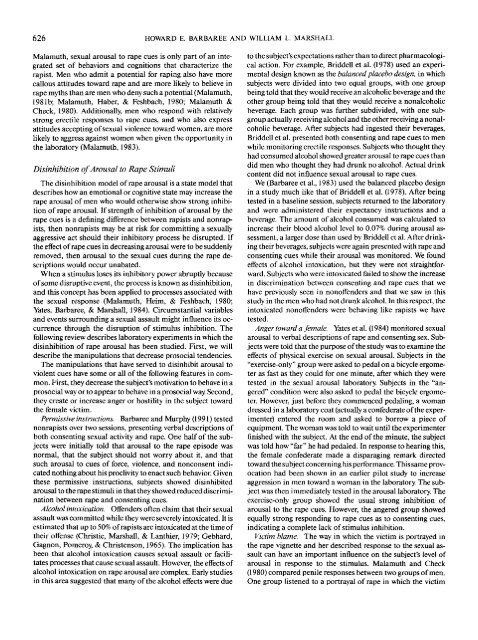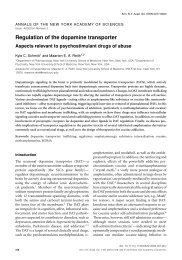The Role of Male Sexual Arousal in Rape: Six Models
The Role of Male Sexual Arousal in Rape: Six Models
The Role of Male Sexual Arousal in Rape: Six Models
You also want an ePaper? Increase the reach of your titles
YUMPU automatically turns print PDFs into web optimized ePapers that Google loves.
626 HOWARD E. BARBAREE AND WILLIAM L. MARSHALL<br />
Malamuth, sexual arousal to rape cues is only part <strong>of</strong> an <strong>in</strong>te-<br />
grated set <strong>of</strong> behaviors and cognitions that characterize the<br />
rapist. Men who admit a potential for rap<strong>in</strong>g also have more<br />
callous attitudes toward rape and are more likely to believe <strong>in</strong><br />
rape myths than are men who deny such a potential (Malamuth,<br />
1981b; Malamuth, Haber, & Feshbach, 1980; Malamuth &<br />
Check, 1980). Additionally, men who respond with relatively<br />
strong erectile responses to rape cues, and who also express<br />
attitudes accept<strong>in</strong>g <strong>of</strong> sexual violence toward women, are more<br />
likely to aggress aga<strong>in</strong>st women when given the opportunity <strong>in</strong><br />
the laboratory (Malamuth, 1983).<br />
Dis<strong>in</strong>hibition <strong>of</strong> <strong>Arousal</strong> to <strong>Rape</strong> Stimuli<br />
<strong>The</strong> dis<strong>in</strong>hibition model <strong>of</strong> rape arousal is a state model that<br />
describes how an emotional or cognitive state may <strong>in</strong>crease the<br />
rape arousal <strong>of</strong> men who would otherwise show strong <strong>in</strong>hibi-<br />
tion <strong>of</strong> rape arousal. If strength <strong>of</strong> <strong>in</strong>hibition <strong>of</strong> arousal by the<br />
rape cues is a def<strong>in</strong><strong>in</strong>g difference between rapists and nonrap-<br />
ists, then nonrapists may be at risk for committ<strong>in</strong>g a sexually<br />
aggressive act should their <strong>in</strong>hibitory process be disrupted. If<br />
the effect <strong>of</strong> rape cues <strong>in</strong> decreas<strong>in</strong>g arousal were to be suddenly<br />
removed, then arousal to the sexual cues dur<strong>in</strong>g the rape de-<br />
scriptions would occur unabated.<br />
When a stimulus loses its <strong>in</strong>hibitory power abruptly because<br />
<strong>of</strong> some disruptive event, the process is known as dis<strong>in</strong>hibition,<br />
and this concept has been applied to processes associated with<br />
the sexual response (Malamuth, Heim, & Feshbach, 1980;<br />
Yates, Barbaree, & Marshall, 1984). Circumstantial variables<br />
and events surround<strong>in</strong>g a sexual assault might <strong>in</strong>fluence its oc-<br />
currence through the disruption <strong>of</strong> stimulus <strong>in</strong>hibition. <strong>The</strong><br />
follow<strong>in</strong>g review describes laboratory experiments <strong>in</strong> which the<br />
dis<strong>in</strong>hibition <strong>of</strong> rape arousal has been studied. First, we will<br />
describe the manipulations that decrease prosocial tendencies.<br />
<strong>The</strong> manipulations that have served to dis<strong>in</strong>hibit arousal to<br />
violent cues have some or all <strong>of</strong> the follow<strong>in</strong>g features <strong>in</strong> com-<br />
mon. First, they decrease the subject's motivation to behave <strong>in</strong> a<br />
prosocial way or to appear to behave <strong>in</strong> a prosocial way. Second,<br />
they create or <strong>in</strong>crease anger or hostility <strong>in</strong> the subject toward<br />
the female victim.<br />
Permissive <strong>in</strong>structions. Barbaree and Murphy (1991) tested<br />
nonrapists over two sessions, present<strong>in</strong>g verbal descriptions <strong>of</strong><br />
both consent<strong>in</strong>g sexual activity and rape. One half <strong>of</strong> the sub-<br />
jects were <strong>in</strong>itially told that arousal to the rape episode was<br />
normal, that the subject should not worry about it, and that<br />
such arousal to cues <strong>of</strong> force, violence, and nonconsent <strong>in</strong>di-<br />
cated noth<strong>in</strong>g about his proclivity to enact such behavior. Given<br />
these permissive <strong>in</strong>structions, subjects showed dis<strong>in</strong>hibited<br />
arousal to the rape stimuli <strong>in</strong> that they showed reduced discrimi-<br />
nation between rape and consent<strong>in</strong>g cues.<br />
Alcohol <strong>in</strong>toxication. Offenders <strong>of</strong>ten claim that their sexual<br />
assault was committed while they were severely <strong>in</strong>toxicated. It is<br />
estimated that up to 50% <strong>of</strong> rapists are <strong>in</strong>toxicated at the time <strong>of</strong><br />
their <strong>of</strong>fense (Christie, Marshall, & Lanthier, 1979; Gebhard,<br />
Gagnon, Pomeroy, & Christenson, 1965). <strong>The</strong> implication has<br />
been that alcohol <strong>in</strong>toxication causes sexual assault or facili-<br />
tates processes that cause sexual assault. However, the effects <strong>of</strong><br />
alcohol <strong>in</strong>toxication on rape arousal are complex. Early studies<br />
<strong>in</strong> this area suggested that many <strong>of</strong> the alcohol effects were due<br />
to the subject's expectations rather than to direct pharmacologi-<br />
cal action. For example, Briddell et ai. (1978) used an experi-<br />
mental design known as the balanced placebo design, <strong>in</strong> which<br />
subjects were divided <strong>in</strong>to two equal groups, with one group<br />
be<strong>in</strong>g told that they would receive an alcoholic beverage and the<br />
other group be<strong>in</strong>g told that they would receive a nonalcoholic<br />
beverage. Each group was further subdivided, with one sub-<br />
group actually receiv<strong>in</strong>g alcohol and the other receiv<strong>in</strong>g a nonal-<br />
coholic beverage. After subjects had <strong>in</strong>gested their beverages,<br />
Briddell et al. presented both consent<strong>in</strong>g and rape cues to men<br />
while monitor<strong>in</strong>g erectile responses. Subjects who thought they<br />
had consumed alcohol showed greater arousal to rape cues than<br />
did men who thought they had drunk no alcohol. Actual dr<strong>in</strong>k<br />
content did not <strong>in</strong>fluence sexual arousal to rape cues.<br />
We (Barbaree et al., 1983) used the balanced placebo design<br />
<strong>in</strong> a study much like that <strong>of</strong> Briddell et al. (1978). After be<strong>in</strong>g<br />
tested <strong>in</strong> a basel<strong>in</strong>e session, subjects returned to the laboratory<br />
and were adm<strong>in</strong>istered their expectancy <strong>in</strong>structions and a<br />
beverage. <strong>The</strong> amount <strong>of</strong> alcohol consumed was calculated to<br />
<strong>in</strong>crease their blood alcohol level to 0.07% dur<strong>in</strong>g arousal as-<br />
sessment, a larger dose than used by Briddell et al. After dr<strong>in</strong>k-<br />
<strong>in</strong>g their beverages, subjects were aga<strong>in</strong> presented with rape and<br />
consent<strong>in</strong>g cues while their arousal was monitored. We found<br />
effects <strong>of</strong> alcohol <strong>in</strong>toxication, but they were not straightfor-<br />
ward. Subjects who were <strong>in</strong>toxicated failed to show the <strong>in</strong>crease<br />
<strong>in</strong> discrim<strong>in</strong>ation between consent<strong>in</strong>g and rape cues that we<br />
have previously seen <strong>in</strong> non<strong>of</strong>fenders and that we saw <strong>in</strong> this<br />
study <strong>in</strong> the men who had not drunk alcohol. In this respect, the<br />
<strong>in</strong>toxicated non<strong>of</strong>fenders were behav<strong>in</strong>g like rapists we have<br />
tested.<br />
Anger toward a female. Yates et al. (l 984) monitored sexual<br />
arousal to verbal descriptions <strong>of</strong> rape and consent<strong>in</strong>g sex. Sub-<br />
jects were told that the purpose <strong>of</strong> the study was to exam<strong>in</strong>e the<br />
effects <strong>of</strong> physical exercise on sexual arousal. Subjects <strong>in</strong> the<br />
"exercise-only" group were asked to pedal on a bicycle ergome-<br />
ter as fast as they could for one m<strong>in</strong>ute, after which they were<br />
tested <strong>in</strong> the sexual arousal laboratory. Subjects <strong>in</strong> the "an-<br />
gered" condition were also asked to pedal the bicycle ergome-<br />
ter. However, just before they commenced pedal<strong>in</strong>g, a woman<br />
dressed <strong>in</strong> a laboratory coat (actually a confederate <strong>of</strong> the exper-<br />
imenter) entered the room and asked to borrow a piece <strong>of</strong><br />
equipment. <strong>The</strong> woman was told to wait until the experimenter<br />
f<strong>in</strong>ished with the subject. At the end <strong>of</strong> the m<strong>in</strong>ute, the subject<br />
was told how "far" he had pedaled. In response to hear<strong>in</strong>g this,<br />
the female confederate made a disparag<strong>in</strong>g remark directed<br />
toward the subject concern<strong>in</strong>g his performance. This same prov-<br />
ocation had been shown <strong>in</strong> an earlier pilot study to <strong>in</strong>crease<br />
aggression <strong>in</strong> men toward a woman <strong>in</strong> the laboratory. <strong>The</strong> sub-<br />
ject was then immediately tested <strong>in</strong> the arousal laboratory. <strong>The</strong><br />
exercise-only group showed the usual strong <strong>in</strong>hibition <strong>of</strong><br />
arousal to the rape cues. However, the angered group showed<br />
equally strong respond<strong>in</strong>g to rape cues as to consent<strong>in</strong>g cues,<br />
<strong>in</strong>dicat<strong>in</strong>g a complete lack <strong>of</strong> stimulus <strong>in</strong>hibition.<br />
Victim blame. <strong>The</strong> way <strong>in</strong> which the victim is portrayed <strong>in</strong><br />
the rape vignette and her described response to the sexual as-<br />
sault can have an important <strong>in</strong>fluence on the subject's level <strong>of</strong><br />
arousal <strong>in</strong> response to the stimulus. Malamuth and Check<br />
(1980) compared penile responses between two groups <strong>of</strong> men.<br />
One group listened to a portrayal <strong>of</strong> rape <strong>in</strong> which the victim










